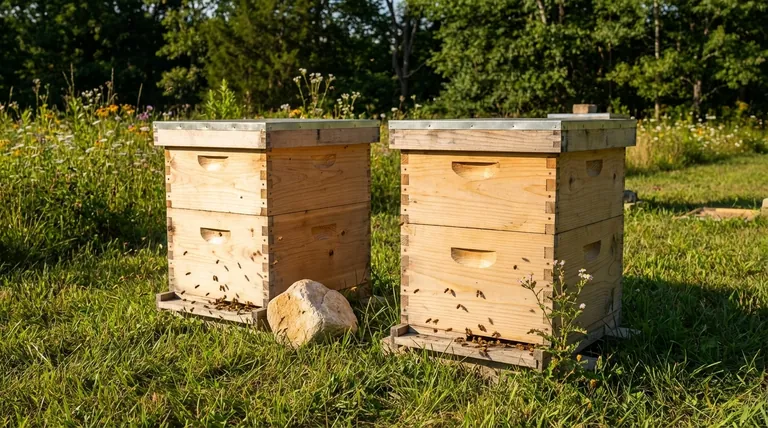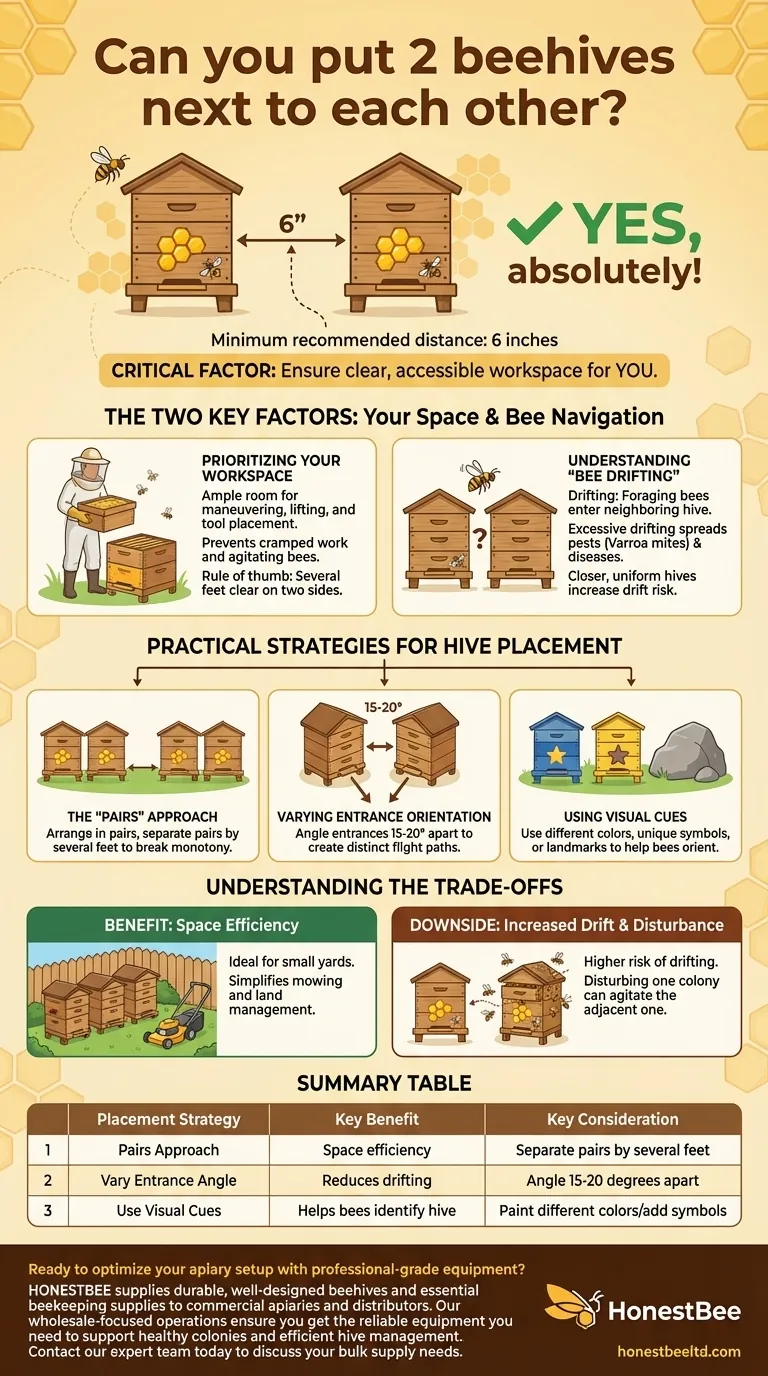Yes, you can absolutely place two beehives next to each other. The minimum recommended distance is as little as six inches between them. However, the more critical factor is not the space between the hives, but the clear, accessible space you leave around them for you to work safely and efficiently.
The question of hive proximity is less about what the bees prefer and more about designing a workspace that is safe for you and minimizes the risk of bees drifting into the wrong home.

The Two Key Factors: Your Space and Bee Navigation
Placing hives is a balance between your convenience as a beekeeper and the bees' natural ability to navigate. Understanding both is essential for a healthy and manageable apiary.
Prioritizing Your Workspace
When you perform a hive inspection, you will need ample room to maneuver. You'll be lifting heavy boxes (supers) and setting them down, temporarily removing frames, and placing your tools.
Failing to leave enough space forces you to work in cramped, awkward positions. This increases the risk of dropping equipment, agitating the bees, and makes the entire process more stressful than it needs to be. A good rule of thumb is to ensure you have several feet of clear space on at least two sides of your hive setup.
Understanding "Bee Drifting"
"Drifting" is a term for when foraging bees return from the field and accidentally enter a neighboring hive instead of their own. This is a natural phenomenon that happens in all apiaries.
While a small amount of drifting is normal, excessive drifting can become a problem. It is a primary way that pests, like Varroa mites, and diseases can spread from a weaker or infected colony to a healthy one.
How Proximity Affects Drifting
The closer and more uniform your hives are, the more likely bees are to drift. When hives are lined up like identical apartment blocks, it can be difficult for returning foragers to distinguish their specific entrance, especially in windy conditions.
Practical Strategies for Hive Placement
You can place hives close together while still mitigating the primary risks. The goal is to give each colony a unique "address" from the bees' perspective.
The "Pairs" Approach
Many beekeepers find success by arranging hives in pairs. The two hives in a pair can be close together, but each pair should be separated from the next by a more significant distance (several feet). This breaks up the visual monotony of a long, single row.
Varying Entrance Orientation
A simple and highly effective strategy is to slightly angle the entrances of adjacent hives away from each other. Even a 15- to 20-degree difference helps create distinct flight paths, making it easier for bees to find the correct entrance.
Using Visual Cues
Bees use landmarks to orient themselves. You can help them by painting your hives different colors or adding unique symbols above the entrance. Placing a distinctive object like a large, light-colored rock or a small plant near one hive can also serve as a crucial visual marker.
Understanding the Trade-offs
Choosing your hive spacing involves balancing efficiency with bee health. There is no single perfect answer, only the best choice for your specific situation.
The Benefit of Close Spacing
The primary advantage of placing hives close together is space efficiency. If you have a small backyard or a designated bee yard with limited room, grouping hives is a practical necessity. It can also make mowing and land management around the apiary simpler.
The Downside of Close Spacing
The main drawbacks are the increased risk of bee drifting and the potential for disturbing adjacent colonies. When you work one hive, the noise, smoke, and vibrations can agitate the colony right next to it, making your inspections more challenging.
Making the Right Choice for Your Apiary
Ultimately, your hive layout should be intentional. It needs to support your bees' health and your ability to care for them effectively.
- If your primary focus is space efficiency: Place hives in pairs 6-12 inches apart, but be sure to angle their entrances away from each other or use distinct visual cues to reduce drifting.
- If your primary focus is minimizing disease risk: Space individual hives at least 3-5 feet apart to create clearly separate flight paths and reduce the chances of drifting.
Designing an apiary that works for both you and your bees is the foundation of successful beekeeping.
Summary Table:
| Placement Strategy | Key Benefit | Key Consideration |
|---|---|---|
| Pairs Approach | Space efficiency for small yards | Separate pairs by several feet to reduce drift |
| Vary Entrance Angle | Reduces bee drifting between hives | Angle entrances 15-20 degrees apart |
| Use Visual Cues | Helps bees identify their own hive | Paint hives different colors or add symbols |
Ready to optimize your apiary setup with professional-grade equipment? HONESTBEE supplies durable, well-designed beehives and essential beekeeping supplies to commercial apiaries and distributors. Our wholesale-focused operations ensure you get the reliable equipment you need to support healthy colonies and efficient hive management. Contact our expert team today to discuss your bulk supply needs and elevate your beekeeping operation.
Visual Guide

Related Products
- Langstroth Bee Hives Bee Keeping Box for Beginners Beekeeping
- Australian Langstroth Beehive Boxes for Beekeeping Wholesales
- Langstroth Honey Bee Box Hive Boxes for Different Depths
- HONESTBEE Professional Long Handled Hive Tool with Precision Cutting Blade
- Professional Insulated Plastic Bee Hives
People Also Ask
- Why are Langstroth hives recommended for beginners? Unmatched Support & Standardization
- Why were wooden hives traditionally preferred? For Natural Beekeeping Aligned with Bee Biology
- Why might a beginner be advised to start with a Langstroth hive? Unlock a Supportive Beekeeping Ecosystem
- What basic equipment is needed to start beekeeping? Your Essential Guide to a Confident Start
- What are the key features of the Langstroth beehive? A Guide to the Standard for Modern Beekeeping



















